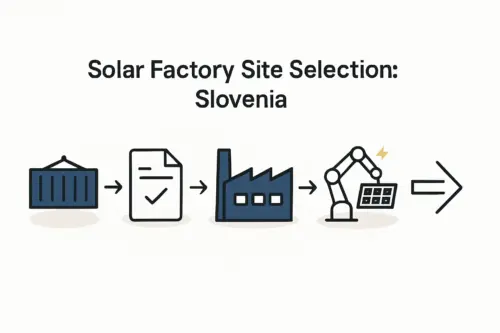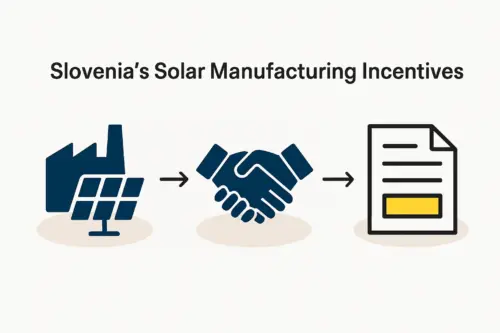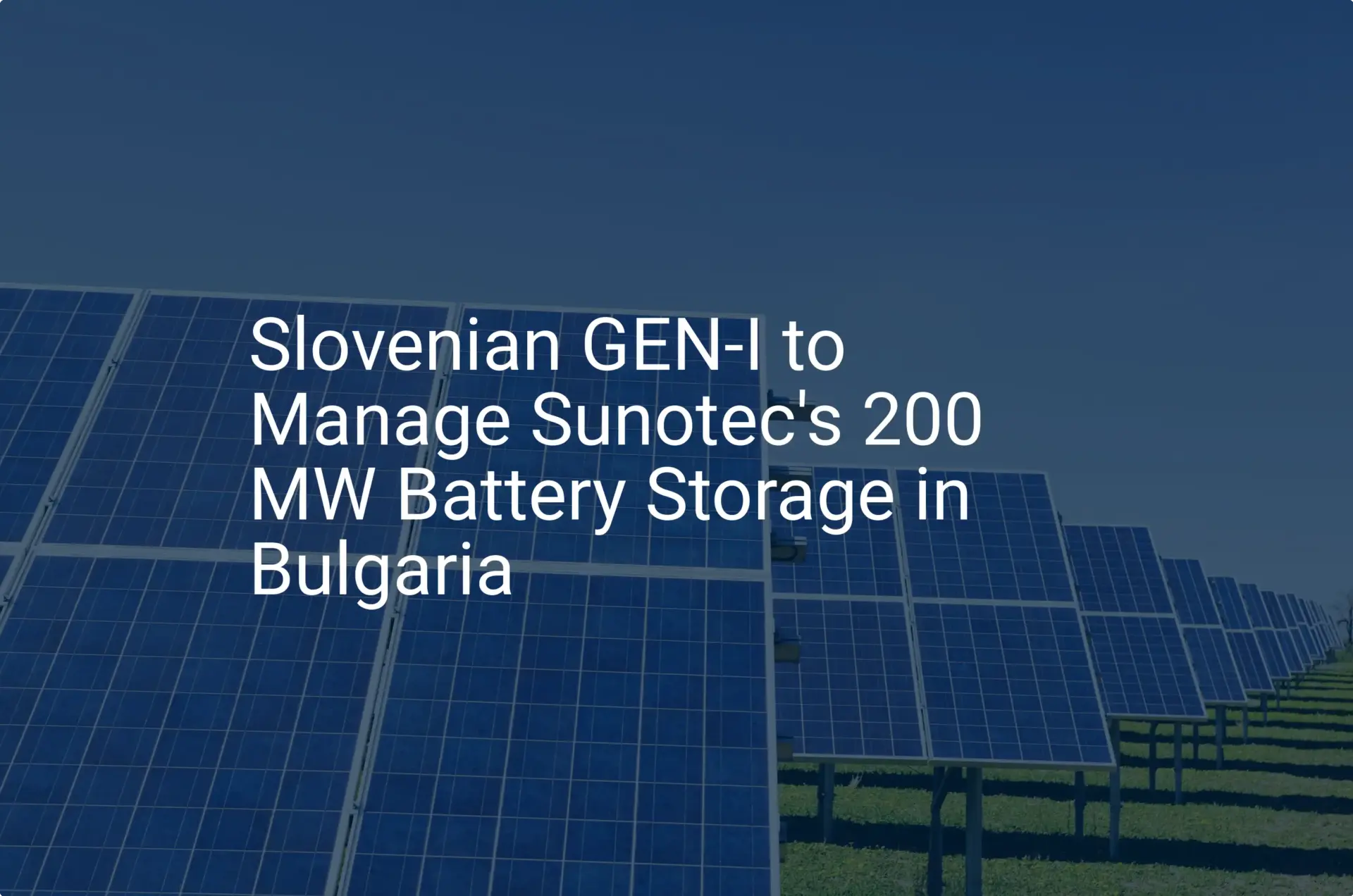When entrepreneurs consider establishing a solar module factory in Europe, their focus often gravitates toward major industrial centers in Germany or the Netherlands, known for their robust infrastructure. However, for businesses targeting the rapidly growing Balkan and Middle East/North Africa (MENA) markets, a more strategic location offers significant competitive advantages: Slovenia.
The business case for choosing Slovenia as a manufacturing base for solar modules is compelling. A closer look at its unique geographical position, logistical efficiencies, and favorable trade agreements reveals why this Central European nation presents a powerful, yet often overlooked, opportunity for export-oriented solar enterprises.
The Geographic Advantage: Why Slovenia’s Location Matters
Slovenia’s key strategic asset is its direct access to the Adriatic Sea through the Port of Koper. As the northernmost port on the Adriatic, Koper serves as a critical gateway, connecting Central and Eastern Europe with the Mediterranean and—via the Suez Canal—the rest of the world.

For a solar module manufacturer, this creates two distinct logistical advantages:
-
Efficient Sea Access to MENA Markets: Shipments from Koper to key ports like Alexandria (Egypt), Haifa (Israel), or Jeddah (Saudi Arabia) bypass the congested and lengthy sea routes from Northern European hubs like Rotterdam or Hamburg. This direct route can shorten transit times by a week or more, reducing shipping costs and improving cash flow.
-
Direct Land Access to the Balkans: Slovenia shares borders with Italy, Austria, Hungary, and Croatia, providing seamless road and rail connections to the entire Balkan peninsula. This enables cost-effective, just-in-time delivery to emerging solar markets such as Serbia, North Macedonia, Albania, and Bosnia and Herzegovina.
This dual-access model—sea for MENA and land for the Balkans—is a unique combination that few other European locations can offer. It positions a single factory to efficiently serve two distinct, high-growth regions.
Unlocking Market Access: Trade Agreements and Logistics
Beyond geography, trade frameworks are a critical component of any export strategy. Operating from within the European Union provides a stable, predictable regulatory environment, while specific agreements offer significant advantages to manufacturers in Slovenia.
The Pan-Euro-Mediterranean (PEM) Convention is a prime example. This agreement establishes a network of free trade agreements between the EU and many countries in the Southern and Eastern Mediterranean, including key MENA solar markets like Egypt, Jordan, and Morocco. For a manufacturer in Slovenia, this means products with ‘Made in Europe’ origin can often be exported with reduced or zero import tariffs, providing a substantial price advantage over competitors from regions without such agreements.
Ready to make big Profits?
The solar Industry is Booming
WE HELP NEWCOMERS to the solar industry start their own solar module production line. Customers can make BIG PROFITS by selling modules and finding investors, without wasting money and time on things they don't need!
Logistics from the factory door to the client’s site are a major cost factor in the full [supply chain for solar manufacturing]. The shorter sea routes from Koper not only save time but also reduce fuel consumption and associated shipping fees.

For entrepreneurs developing their initial [solar panel manufacturing business plan], accounting for these logistical savings and tariff advantages can fundamentally alter the project’s financial viability, making a European production base competitive against Asian imports in these specific target markets.
The ‘Made in Europe’ Premium: Quality and Trust
In markets where project bankability and long-term performance are paramount, the origin of the solar modules carries significant weight. The ‘Made in Europe’ label acts as a powerful mark of quality, adherence to stringent environmental and labor standards (ESG), and technological reliability.
Slovenia, with its long industrial history and highly skilled technical workforce, is well-positioned to uphold this standard. A manufacturing facility in the country benefits from:
- A Culture of Precision Engineering: The workforce is experienced in complex manufacturing processes and quality control systems.
- EU Standards and Certifications: Products are manufactured to meet all required European Norms (EN) and IEC certifications, which are globally recognized and trusted.
- Brand Perception: Sourcing from a politically stable, EU-based supplier de-risks the investment and simplifies financing for large-scale solar projects in the MENA region or government-backed initiatives in the Balkans.
Establishing a [turnkey solar module production line] in Slovenia ensures the facility is built from the ground up to meet these high expectations, producing modules that command trust and justify a potential price premium.

J.v.G.’s experience with turnkey projects shows that clients in emerging markets increasingly prioritize long-term reliability over minimal upfront cost, creating strong demand for high-quality, European-made modules.
Frequently Asked Questions (FAQ)
Is Slovenia a good location for a first-time manufacturer?
Slovenia can be an excellent choice. It offers the stability and legal security of an EU member state, a skilled and relatively cost-effective workforce compared to Western Europe, and well-developed infrastructure. For entrepreneurs without prior manufacturing experience, the clear logistical pathways and stable business environment can reduce operational complexity.
How does the PEM Convention directly help with exports?
The PEM Convention allows for ‘diagonal cumulation of origin.’ In simple terms, this means materials from one member country can be processed in another (e.g., your Slovenian factory), and the final product still qualifies for preferential tariff treatment when exported to a third member country (e.g., Morocco). This simplifies sourcing and provides a significant cost advantage upon import into the target market.
What are the primary logistical benefits of the Port of Koper?
The main benefits are speed and cost efficiency for specific routes. Compared to Northern European ports, Koper offers:
- Shorter Sea Transit: 7-10 days saved on routes to the Eastern Mediterranean and MENA.
- Reduced Inland Transport: It is closer to many Central and Eastern European suppliers.
- Direct Balkan Access: It acts as the primary seaport for several landlocked Balkan nations.
Isn’t it more expensive to manufacture in Slovenia than in Asia?
While direct labor and operational costs in Slovenia are higher than in many parts of Asia, a comprehensive cost analysis often reveals a more nuanced picture. The final ‘landed cost’ at the project site can be competitive due to:
- Lower shipping costs to Balkan and MENA regions.
- Avoidance of import tariffs due to trade agreements.
- Reduced inventory costs because of shorter lead times.
- The ‘Made in Europe’ brand premium allowing for better pricing.
A detailed financial model is necessary to compare these factors accurately. A thorough evaluation of such strategic trade-offs is a key part of learning [how to start a solar panel factory].
Conclusion: A Strategic and Calculated Choice
Selecting a location for a solar module factory is one of the most critical decisions an entrepreneur will make. While traditional manufacturing hubs have their merits, a strategy focused on the Balkan and MENA markets requires a different perspective.
Slovenia offers a unique and powerful combination of geographic positioning, logistical efficiency, favorable trade access, and the trusted ‘Made in Europe’ brand. For discerning investors looking to build a resilient and competitive export-oriented business, it represents a strategic choice that deserves serious consideration. Understanding these nuanced advantages is the first step toward building a successful enterprise in the global solar industry.






